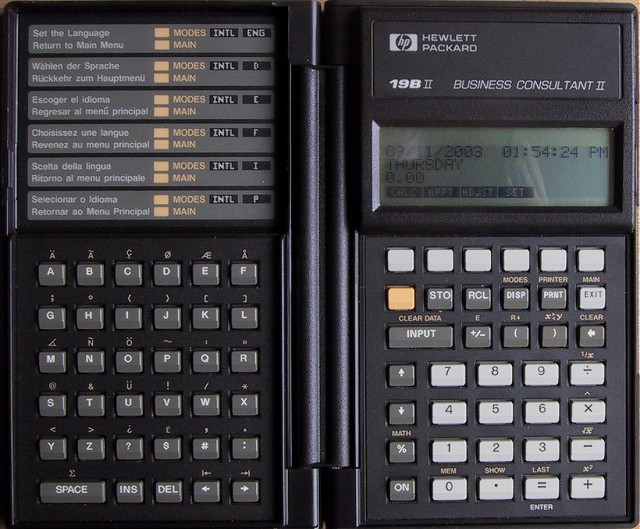hp 19bii
| here is the 19bii business consultant.
it has similar, but expanded, functionality to the hp17bii, another financial model.. built in the same style as the hp28c. like a book that opens it can be laid flat on a desk or folded back on itself so as to be handheld like any other pocket machine. this system works rather nicely because unlike the 17bii, text is easy to input. indeed this model has specific text based features for storing notes, names & addresses, telephone numbers and so on (a precursor to todays pdas). there's even an appointments calendar with alarms. all the usual financial features are available including percentages, markup & discount, currency conversions, tvm, cashflow, bonds, depreciation and statistics. like the 17bii, date and time arithmetic are here too including actual days, 360 days and 365 days as a bonus, unit conversions are here too. |
 |
like the 28c it is powered by 3 n-cells (the shorter AAA cells) which live in a cavity above the display. this model had a small rubber edge lining inside the battery compartment, presumably this helps prevent rattle, but also acts as a barrier to getting the batteries out. especially the innermost one which involves cussing and the use of long nodes pincers.
the machine works to 12 digits and can exponent to +/-499, it operates in any of six different languages and accommodates mode selections for the display format of numbers (ie commas and periods) and dates (dd.mmyyyy or mm.ddyyyy). even better is the operational mode can be either rpn or algebraic. like the 17bii, this selectability works superbly and suits everyone.
the tvm and cashflow features have the rigour of the 12c in terms of getting the right answers (surprisingly difficult, see this), but a lot quicker. it does miss out of the tvm fractional n, odd period facility of the 12c.
where this model really starts to motor is the solver. the 17bii also has a very nice solver, but somewhat limited memory. this model makes using the solver a breeze with its text keypad and it has 6,600 bytes of storage - not a lot by today's standards, but enough. furthermore, formulae can be named and variable names multi character (useful for prompting).
the solver first tries to isolate a solution symbolically. presumably it has some of the capacity of the 28c in terms of being able to internally re-arrange formulae. this works well when the target variable occurs only once in a formula and, as you'd expect, the solution is always spot on.
when it can't rearrange (most of the time), it uses an iterative process. what is really cool is that formulae can involve conditionals and summation loops (a bit like a functional program) and it can still solve for any variable given the others. the function language can make us of any other built-in feature (like tvm, cashflow, date arithmetic and so on) as well as structural features like IF(con: t-exp: f-exp), and, or, min, max and sum. this is the sort of thing done today in excel.
there are several examples in the manual where completely new financial problems can be added with sophisticated solver programs.